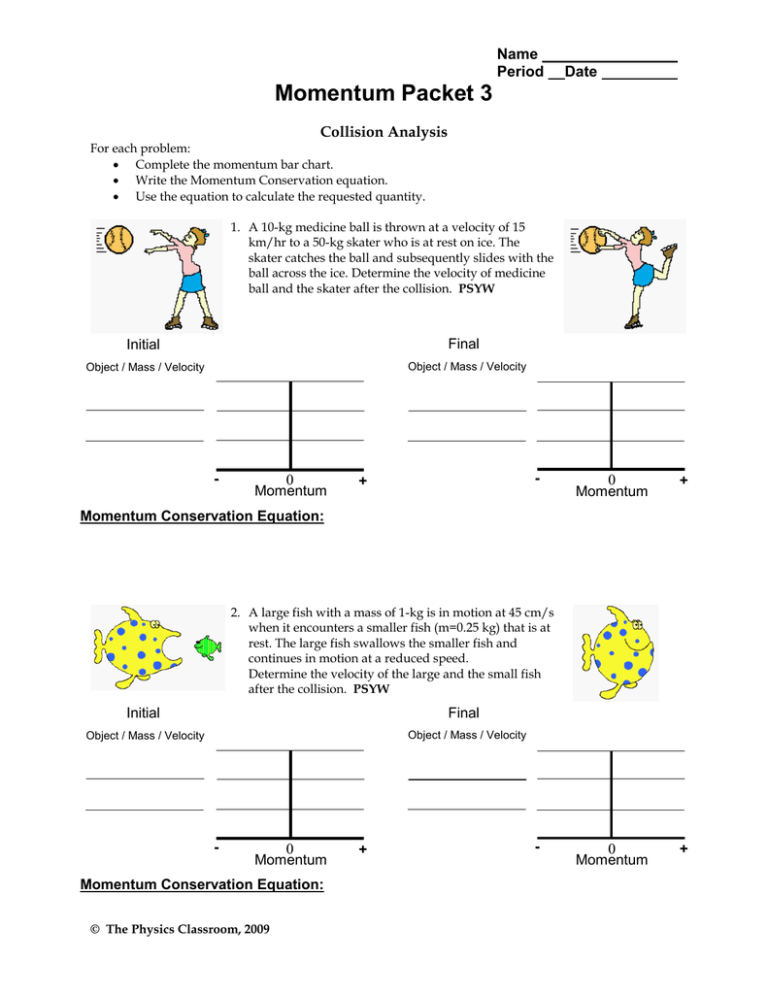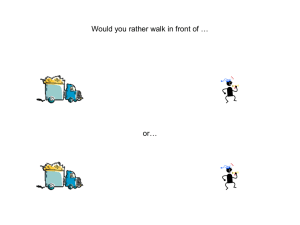Momentum Packet 3 Name Period Date
advertisement

Name Period Date Momentum Packet 3 Collision Analysis For each problem: Complete the momentum bar chart. Write the Momentum Conservation equation. Use the equation to calculate the requested quantity. 1. A 10-kg medicine ball is thrown at a velocity of 15 km/hr to a 50-kg skater who is at rest on ice. The skater catches the ball and subsequently slides with the ball across the ice. Determine the velocity of medicine ball and the skater after the collision. PSYW Final Initial Object / Mass / Velocity Object / Mass / Velocity - 0 Momentum - + 0 Momentum + 0 Momentum + Momentum Conservation Equation: 2. A large fish with a mass of 1-kg is in motion at 45 cm/s when it encounters a smaller fish (m=0.25 kg) that is at rest. The large fish swallows the smaller fish and continues in motion at a reduced speed. Determine the velocity of the large and the small fish after the collision. PSYW Final Initial Object / Mass / Velocity Object / Mass / Velocity - 0 Momentum Momentum Conservation Equation: © The Physics Classroom, 2009 + - Momentum Packet 3 3. page 2 A 0.150-kg baseball moving at a speed of 45.0 m/s crosses the plate and strikes the 0.250-kg catcher's mitt (originally at rest). The catcher's mitt immediately recoils backwards (at the same speed as the ball) before the catcher applies an external force to stop its momentum. If the catcher's hand is in a relaxed state at the time of the collision, it can be assumed that no net external force exists and the law of momentum conservation applies to the baseballcatcher's mitt collision. Determine the velocity of the baseball/catcher's mitt immediately after the collision. PSYW Final Initial Object / Mass / Velocity Object / Mass / Velocity - 0 Momentum + - 0 Momentum + - 0 Momentum + Momentum Conservation Equation: 4. A 4800-kg truck traveling with a velocity of +4.0 m/s collides head-on with a 1200-kg car traveling with a velocity of -12 m/s. The truck and car entangle and move together after the collision. Determine the velocity of the truck and car immediately after the collision. PSYW Final Initial Object / Mass / Velocity Object / Mass / Velocity - 0 Momentum Momentum Conservation Equation: © The Physics Classroom, 2009 + Momentum Packet 3 page 3 Momentum Problem-Solving Read from Lesson 2 of the Momentum and Collisions chapter at The Physics Classroom: MOP Connection: 1. Momentum and Collisions: sublevels 8 and 9 Determine the post-collision velocities of the following objects or combination of objects. a. b. c. d. e. f. © The Physics Classroom, 2009 Momentum Packet 3 page 4 2. A 2.1-kg brick is placed gently upon a 2.9-kg cart originally moving with a speed of 26 cm/s. Determine the post-collision speed of the combination of brick and cart. 3. A 98-kg fullback is running along at 8.6 m/s when a 76-kg defensive back running in the same direction at 9.8 m/s jumps on his back. What is the post-collision speed of the two players immediately after the tackle? 4. A 0.112-kg billiard ball moving at 154 cm/s strikes a second billiard ball of the same mass moving in the opposite direction at 46 cm/s. The second billiard ball rebounds and travels at 72 cm/s after the head-on collision. Determine the post-collision velocity of the first billiard ball. 5. A 225-kg bumper car (and its occupant) is moving north at 98 cm/s when it hits a 198-kg car (occupant mass included) moving north at 28 cm/s. The 198-kg car is moving north at 71 cm/s after the head-on collision. Determine the post-collision velocity of the 225-kg car. 6. A 4.88-kg bowling ball moving east at 2.41 m/s strikes a stationary 0.95-kg bowling pin. Immediately after the head-on collision, the pin is moving east at 5.19 m/s. Determine the postcollision velocity of the bowling ball. © The Physics Classroom, 2009 Momentum Packet 3 page 5 Momentum Conservation as a Guide to Thinking Read from Lesson 2 of the Momentum and Collisions chapter at The Physics Classroom: MOP Connection: 1. Momentum and Collisions: sublevel 10 The following diagrams depict inelastic collisions between objects of different mass. For each case, determine the post-collision velocity (v') of the two coupled objects. Express v' in terms of v. a. b. d. c. e. f. g. h. i. j. © The Physics Classroom, 2009 Momentum Packet 3 2. page 6 Complete the following verbal statements to illustrate your understanding of the effect of varying mass on the post-collision velocity. a. If an object of mass m and velocity v collides and sticks to an object of mass 3m that is initially at rest, then the amount of total system mass in motion will increase by a factor of _______ and the velocity of the system will decrease by a factor of _______ . The new velocity (v') will be _______ v. b. If an object of mass m and velocity v collides and sticks to an object of mass 4m that is initially at rest, then the amount of total system mass in motion will increase by a factor of _______ and the velocity of the system will decrease by a factor of _______ . The new velocity (v') will be _______ v. c. If an object of mass 3m and velocity v collides and sticks to an object of mass 4m that is initially at rest, then the amount of total system mass in motion will increase by a factor of _______ and the velocity of the system will decrease by a factor of _______ . The new velocity (v') will be _______ v. d. If an object of mass 5m and velocity v collides and sticks to an object of mass 3m that is initially at rest, then the amount of total system mass in motion will increase by a factor of _______ and the velocity of the system will decrease by a factor of _______ . The new velocity (v') will be _______ v. 3. Use proportional reasoning to determine the unknown quantity in the following collisions. a. © The Physics Classroom, 2009 b.






